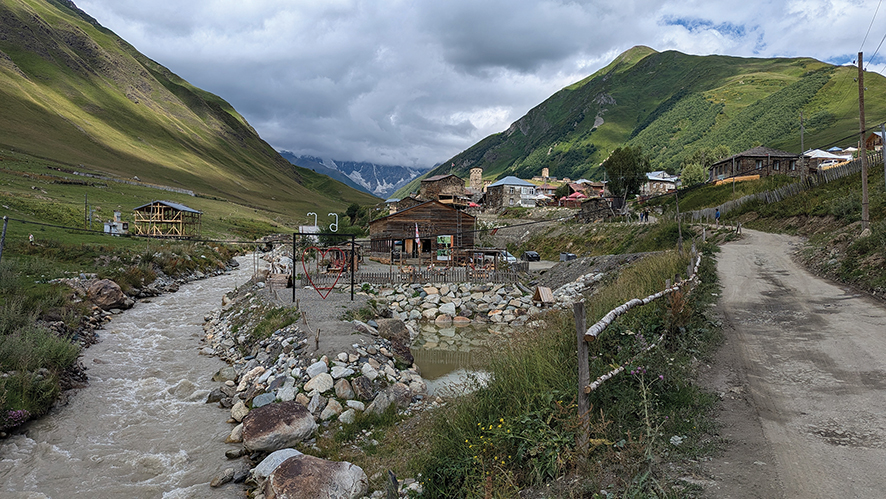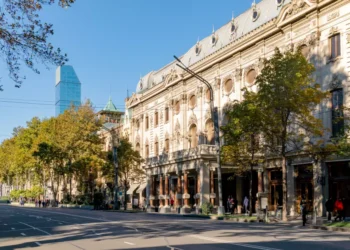During my 14 years in Georgia, I’ve explored many regions, but Lechkhumi and Lower Svaneti hold a special place in my heart. The promise of lush green mountains like Khvamli, cascading rivers like Tskhenistsqali, and majestic peaks has always captivated me. I also appreciate that these regions are less travelled, allowing for a more authentic and peaceful experience.
Imagine hiking through alpine meadows, with the legendary Tskhenistsqali river winding its way through the valley below. From the summit, the world stretches out before you, a breathtaking panorama of nature’s beauty. With every step, you feel a sense of freedom and adventure that’s hard to find anywhere else.
Many infrastructure improvements have made vacations in Lechkhumi and Lower Svaneti easier and more comfortable. These projects include new roads and bridges. For instance, there is a new road leading to the legendary Mount Khvamli, starting from the picturesque village of Okrakhushi in Lechkhumi. Additionally, you can find a new road leading to the Green Lake in Kulbaki village, where you can enjoy fresh fish from the ponds in a very pleasant restaurant.
Lower Svaneti is an amazing place, where the harsh beauty of the mountains is softened by the warmth of human settlements. Unlike its more famous neighbor, Upper Svaneti, with its majestic towers and harsh climate, Lower Svaneti captivates with its gentle landscapes, gardens bathed in sunlight, and cozy villages. Here, among the green meadows and forests, you can find old stone houses, many of which are unfortunately abandoned, but some have preserved their original beauty and have even been decorated with elegant wooden balconies, reminiscent of Tbilisi’s charm.
I always felt a certain guilt when I left Lower Svaneti to go to more famous and popular places. After all, this part of Svaneti, like a younger sister, often remains in the shadow of its famous relative. But it is in this peace and quiet that you can truly feel the soul of Georgia.
Lower Svaneti is not only majestic mountains, dense forests, and rushing rivers, but also a treasure trove of cultural heritage. Many ancient churches, painted by unknown talented masters, hold the secrets of the past.

We embarked on a journey to the forgotten balneological resort of Muashi. Nestled at 1300 meters above sea level, amidst a pristine spruce forest, we discovered a meadow dotted with mineral springs. One such spring, near a cluster of abandoned houses, offered crystal-clear, cool, and slightly effervescent water. Locals spoke of other hidden springs perfect for bathing, but we were unable to find them.
Faced with a difficult choice, we stood at a crossroads: venture to the abandoned village of Zeskho and the enigmatic lake beyond, or return to the enchanting embrace of Upper Svaneti. The image of standing on the lakeshore, gazing out at the vast landscapes of Svaneti and Racha, filled us with anticipation.
However, the allure of Upper Svaneti proved too strong, and we reluctantly postponed our visit to Zeskho. While disappointed, we knew that our adventures were far from over.
Upper Svaneti and its mountain passes
The South Svanetian road is a legendary journey from Lower to Upper Svaneti, crossing the 2616-meter-high Zagaro Pass. Once a popular tourist route in Soviet times, the road has seen better days.
In autumn 2019, my Berlin friends and I embarked on an unforgettable adventure to Ushguli, the heart of Svaneti. However, the perilous condition of the road almost claimed my car. Construction work had turned sections of the road into a treacherous obstacle course, testing our driving skills to the limit. It took us nearly an entire day to navigate this challenging route.
Reaching Ushguli at sunset, I was captivated by the breathtaking views of the snow-capped peaks of the Greater Caucasus. Yet, I couldn’t help but imagine the vibrant alpine meadows in full bloom during the summer, as the autumn sun had scorched much of the vegetation.
The newly upgraded South Svaneti road transformed our latest journey to Ushguli. The smooth asphalt drive was a stark contrast to the rugged, untamed beauty of the mountains. After following the tranquil Tskhenistsqali gorge for some time, the road began its ascent. Pausing at a towering stone pyramid, we, along with a German couple in a massive campervan, took in the stunning panorama of Mount Ailama (4546 m) and the glacial-fed Koruldashi River. It was a powerful reminder of how quickly civilization can give way to the pristine beauty of nature.
The moraine and glacier loomed before us like colossal sentinels. Their sheer size and beauty captivated my son, who immediately expressed a desire to get up close to the glacier’s glistening surface. Though it seemed within arm’s reach, the reality was a challenging trek through a turbulent river and dense forest. It would take at least three to four hours to reach Ailama.
The road to the pass was still under construction, with a gravel surface that had been washed away in places by mountain streams and heavy machinery. Despite the unfinished sections, ordinary cars could navigate the road with relative ease. While our progress was slowed by frequent detours around slow-moving trucks, the overall journey was incredibly rewarding.
The challenges of the road were quickly forgotten as we were enveloped by the breathtaking beauty of the surrounding landscape. The thunderous mountain rivers, towering cliffs, and deep gorges created a sense of perfect harmony with the natural world. The forest soon gave way to alpine meadows dotted with gnarled birch trees, silent sentinels of nature’s ancient magic. My son loved the ever-changing views and begged to explore the mountains on foot. His eyes sparkled with excitement. Was it the invigorating mountain air or the energy of the mountains that filled him with such joy? Whatever it was, his enthusiasm was contagious, and I found myself smiling and longing to join him in his adventure. But I had to keep in mind that we could easily get lost in the mountains.
Even though the wildflowers were past their peak, the alpine meadows were still a feast for the eyes. The colourful blooms that lined the road made the journey feel like a celebration. Each bend in the road revealed new and breathtaking scenery. When we saw the first horses grazing by the roadside, we knew that we were close to reaching the legendary village of Ushguli, the highest permanently inhabited settlement in Europe at 2200 meters above sea level.

Ushguli today
Ushguli is a place where contented cows graze lazily against the backdrop of ancient Svan towers and the majestic, snow-capped peaks of Shkhara. But the tranquil scene is disrupted by the hustle and bustle of construction. The village, with its three distinct parts, is undergoing a rapid transformation, as if trying to compress a thousand years of development into a decade. While this modernization is necessary, there’s a concern that Ushguli might lose its unique character in the process. The jarring contrast between the traditional stone houses, many of which are UNESCO-protected, and the new, plastic-framed windows is a prime example of this.
Despite everything, my son was thrilled by Ushguli. He hadn’t expected to see “such civilization” amidst the stunning medieval panorama of the village with its monumental towers.
Moreover, there was a Babel-like confusion and multilingual chaos: in addition to Georgian, you could hear English, Spanish, and even Japanese, as well as Hebrew, mixed with Russian, at every turn.
We took a break to enjoy the views of Shkhara from the terrace of a colourful cafe and at the same time refresh ourselves with a couple of slices of watermelon and melon. Incidentally, we paid a price for this feast that was comparable to Manhattan! It became clear to us then that tourism had become the main source of income for local residents.
Getting Closer to the Roots. Kala Community, Hotel Phesvebi
We decided to base ourselves in the village of Kala, in Upper Svaneti, as it offered easy access to the Latpari Pass trail, our hiking destination for the next day.
Nestled in a gorge, the Kala community is located six kilometers from Ushguli. Our hotel, Phesvebi (which means “Roots” in Georgian), was perched high on a mountainside. Just above the hotel, a new hiking trail was being developed, connecting Kala to the village of Adishi, famous for its glacier. The four-hour trek to Adishi would require crossing a turbulent river, but locals were said to be on hand to assist tourists by ferrying them across on horseback.
Before dinner, we decided to take a short hike to stretch our legs after the journey. In Svaneti, nature and history are so intertwined that you feel their re-energized simply by stepping outside. A ten-minute hike above the village rewarded us with stunning panoramic views. The Church of Saints Qvirike and Ivlite, perched on a nearby mount, seemed almost within reach. It is considered one of the most sacred sites in the region.
We spent the night in a charming stone house that had been lovingly converted into a hotel. The fresh scent of wood permeated every room, from the walls to the stairs. Our hostess welcomed us and invited us to choose our favourite room. Every detail, from the intricately folded towels to the cozy reading nook in the living room, showed that the hosts had put a lot of thought and care into creating a welcoming space.
We feasted on a delicious meal of chicken, salads, fried potatoes with tkemali sauce, and cheese. But it was the chvishtari, Svan cornbread, that stole the show. These savory pastries are the perfect fuel for long hikes.
The story of Phesvebi Hotel is one of passion and perseverance. Natalie, the owner, had long dreamed of creating a special place in her homeland. After years of working in the Italian hospitality industry, she returned to Svaneti to turn her dream into reality. With determination and hard work, she transformed her family’s abandoned house, damaged by an avalanche in 1987, into a welcoming hotel. Imagine renovating a house in a remote area with limited resources – it’s truly remarkable! Natalie’s story is a testament to the power of human spirit.
Blog by Tatjana Montik














